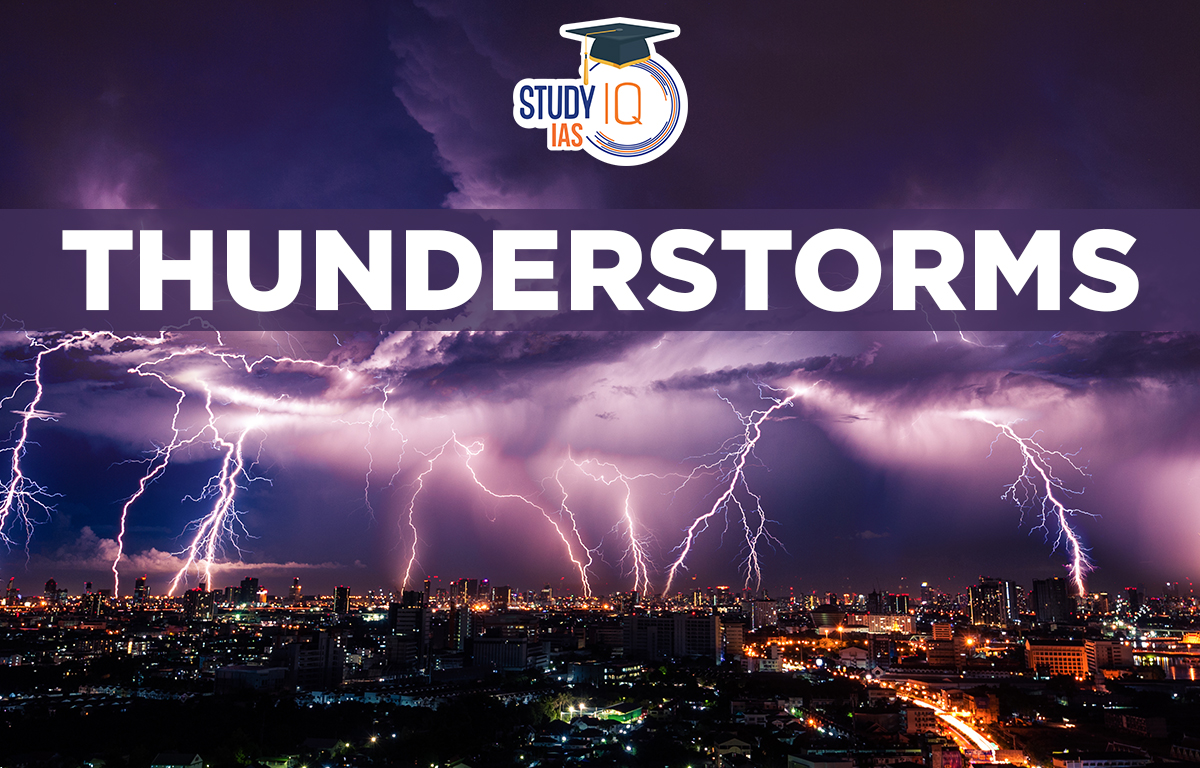Table of Contents
Thunderstorms
A thunderstorm is a strong weather event related to large, tall clouds called cumulonimbus, where air rises quickly. Thunderstorms bring heavy rain, often called “cloud bursts,” but the rain usually lasts only a short time. This article explains how thunderstorms form from rising and falling air. It also describes the three stages of a thunderstorm: the cumulus stage, the mature stage, and the dissipating stage. This information will be very helpful for those preparing for the UPSC IAS Exam.
Thunderstorm Structure
A thunderstorm has several parts called convective cells, which are marked by strong upward air movement. Each cell goes through three stages: young, mature, and old.
| Stage | Details |
| First Stage | It is the cumulus stage when warm air rises strongly upward and helps in the formation of clouds. |
| Second Stage | It is a mature stage characterized by both the upward and downward movement of winds and the occurrence of rainfall. |
| Third stage | The third stage is dissipating stage, characterized by the downward movement of winds that spread over the ground surface and stop the vertical movement of winds. |
Read More: Types of Winds
Thunderstorms Formation
Thunderstorms are caused by Cumulonimbus Clouds, which form when warm, moist air rises quickly. These clouds can reach heights of over 20 kilometers. As the warm air rises, it cools and turns into water droplets or ice when it reaches its dew point.
Any precipitation that falls through the clouds it travels a long way to the ground. Smaller droplets collide to create larger ones. As these droplets fall, they pull down cold air, creating strong winds that are common in thunderstorms.
- Three main ingredients for a thunderstorm: Moisture, Rising unstable air and A lifting mechanism
- The sun heats the earth’s surface, warming the air above it.
- Warm air rises, especially near hills or where different air masses meet. It keeps rising if it’s lighter and warmer than the surrounding air.
- As the air rises, it cools, turning water vapor into clouds.
- The cloud grows upward into freezing temperatures, forming ice particles.
- Ice particles grow by collecting vapor and smaller liquid drops.
- When ice particles collide, they gain electric charge. This buildup of charges creates lightning and thunder.
Thunderstorm and Weather
Surface heating through intense insolation, mainly during summer on land surfaces, causes a convective mechanism resulting in an updraft of air and condition for precipitation.
1. Rainfall
Rainfall is in the form of a heavy downpour with the greatest intensity of all other forms of precipitation but of short duration.
2. Hailstorm
When condensation occurs below the freezing point, ice particles of big size are formed. Not every thunderstorm produces hail. Hail falls on the ground surface when they are capable of overcoming the force of rising convection currents.
3. Lighting
In a mature thunderstorm, areas with electric charges form. Positive charges build up in the upper part of the clouds, while negative charges gather in the lower part. Lightning happens when the difference between these charges becomes very strong.
4. Thundering
Sound is produced due to the sudden and rapid expansion of air columns caused by intense heat resulting from lightning strokes.
Read More: Types of Clouds
Are Thunderstorms Dangerous?
- Thunderstorms can be very dangerous for people and the environment.
- They cause flash floods and large hailstones.
- Flash floods kill more people each year than hurricanes, tornadoes, or lightning.
- Strong thunderstorm cells can create tornadoes and waterspouts.
- Lightning causes many fires and can be deadly.
- Hail can be as big as softballs, damaging vehicles and harming livestock.
- Strong winds from thunderstorms can damage trees, power lines, and public property.
- Tornadoes can reach speeds of up to 300 miles per hour, destroying almost everything except well-built structures.
Read More: Types of Rocks
Thunderstorms UPSC
- Tornadoes and thunderstorms are severe local storms. They are brief and occur over a small area, but they are violent.
- A thunderstorm is a storm that includes thunder and lightning, as well as heavy rain or hail.
- Thunderstorms are most common when the temperature is high. Because of the cold, thunderstorms are less common in bodies of water.
- Every year, an estimated 16 million thunderstorms occur worldwide, with approximately 2,000 thunderstorms active at any given time.


 Role of Teachers in Educations, Student ...
Role of Teachers in Educations, Student ...
 India's achievements after 75 years of I...
India's achievements after 75 years of I...
 Bal Gangadhar Tilak Biography, Achieveme...
Bal Gangadhar Tilak Biography, Achieveme...

























